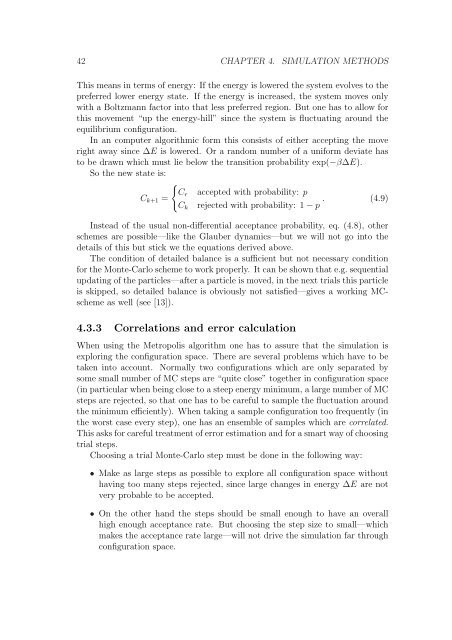Polymers in Confined Geometry.pdf
Polymers in Confined Geometry.pdf
Polymers in Confined Geometry.pdf
Create successful ePaper yourself
Turn your PDF publications into a flip-book with our unique Google optimized e-Paper software.
42 CHAPTER 4. SIMULATION METHODS<br />
This means <strong>in</strong> terms of energy: If the energy is lowered the system evolves to the<br />
preferred lower energy state. If the energy is <strong>in</strong>creased, the system moves only<br />
with a Boltzmann factor <strong>in</strong>to that less preferred region. But one has to allow for<br />
this movement “up the energy-hill” s<strong>in</strong>ce the system is fluctuat<strong>in</strong>g around the<br />
equilibrium configuration.<br />
In an computer algorithmic form this consists of either accept<strong>in</strong>g the move<br />
right away s<strong>in</strong>ce ∆E is lowered. Or a random number of a uniform deviate has<br />
to be drawn which must lie below the transition probability exp(−β∆E).<br />
So the new state is:<br />
<br />
Cr accepted with probability: p<br />
Ck+1 =<br />
. (4.9)<br />
Ck rejected with probability: 1 − p<br />
Instead of the usual non-differential acceptance probability, eq. (4.8), other<br />
schemes are possible—like the Glauber dynamics—but we will not go <strong>in</strong>to the<br />
details of this but stick we the equations derived above.<br />
The condition of detailed balance is a sufficient but not necessary condition<br />
for the Monte-Carlo scheme to work properly. It can be shown that e.g. sequential<br />
updat<strong>in</strong>g of the particles—after a particle is moved, <strong>in</strong> the next trials this particle<br />
is skipped, so detailed balance is obviously not satisfied—gives a work<strong>in</strong>g MCscheme<br />
as well (see [13]).<br />
4.3.3 Correlations and error calculation<br />
When us<strong>in</strong>g the Metropolis algorithm one has to assure that the simulation is<br />
explor<strong>in</strong>g the configuration space. There are several problems which have to be<br />
taken <strong>in</strong>to account. Normally two configurations which are only separated by<br />
some small number of MC steps are “quite close” together <strong>in</strong> configuration space<br />
(<strong>in</strong> particular when be<strong>in</strong>g close to a steep energy m<strong>in</strong>imum, a large number of MC<br />
steps are rejected, so that one has to be careful to sample the fluctuation around<br />
the m<strong>in</strong>imum efficiently). When tak<strong>in</strong>g a sample configuration too frequently (<strong>in</strong><br />
the worst case every step), one has an ensemble of samples which are correlated.<br />
This asks for careful treatment of error estimation and for a smart way of choos<strong>in</strong>g<br />
trial steps.<br />
Choos<strong>in</strong>g a trial Monte-Carlo step must be done <strong>in</strong> the follow<strong>in</strong>g way:<br />
• Make as large steps as possible to explore all configuration space without<br />
hav<strong>in</strong>g too many steps rejected, s<strong>in</strong>ce large changes <strong>in</strong> energy ∆E are not<br />
very probable to be accepted.<br />
• On the other hand the steps should be small enough to have an overall<br />
high enough acceptance rate. But choos<strong>in</strong>g the step size to small—which<br />
makes the acceptance rate large—will not drive the simulation far through<br />
configuration space.













